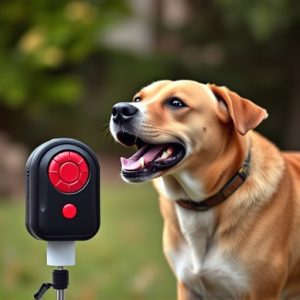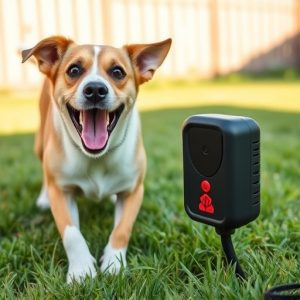Electronic Dog Deterrents: Effective Vibration Settings for Aggressive Behavior
When developing an electronic dog repellent device, understanding individual canine behavior and agg…….
When developing an electronic dog repellent device, understanding individual canine behavior and aggression is key. The "best" vibration settings vary based on dog sensitivity and targeted behavior, with lower vibrations as gentle reminders and higher settings as stronger deterrents. Personalized training using positive reinforcement enhances these devices' effectiveness. With adjustable intensity levels, users can tailor settings from subtle alerts to robust deterrents, ensuring comfort and maximum impact during testing. Optimal placement at waist height and regular maintenance ensure these humane, non-lethal devices successfully manage unwanted dog trespass in various environments.
“Unleash a safer, more peaceful environment with aggressive dog deterrent electronic solutions. This comprehensive guide delves into understanding canine aggression and its underlying causes. We explore the science behind these innovative devices, offering a step-by-step guide to selecting the best vibration settings for optimal effectiveness. Learn from real-world case studies showcasing successful implementations of electronic dog repellent devices. Discover how these solutions revolutionize pet management while ensuring the well-being of both pets and humans.”
- Understanding Dog Behavior and Aggression: Uncovering the Root Cause
- The Science Behind Electronic Dog Deterrents: How They Work
- Choosing the Right Vibration Settings: A Comprehensive Guide
- Best Practices for Implementing an Electronic Dog Repellent Device
- Case Studies: Success Stories of Effective Dog Deterrent Solutions
Understanding Dog Behavior and Aggression: Uncovering the Root Cause
Understanding dog behavior and aggression is key to developing an effective electronic deterrent solution. Dogs, like humans, have unique personalities and triggers; what may be a harmless interaction for one pup could be perceived as a threat by another. Aggression can stem from various sources such as fear, territorial instincts, or past trauma. For example, a dog that hasn’t been socialized adequately might react aggressively to unfamiliar people or animals due to fear and uncertainty. Identifying these root causes is crucial when choosing the best vibration settings for a dog repellent device.
Using devices with adjustable vibration levels can help in desensitizing dogs to specific triggers without causing harm or fear. The “best” vibration setting would depend on the dog’s sensitivity and the specific behavior targeted. For instance, lower vibrations might be effective for gentle reminders while higher settings could serve as more intense deterrents. Regular, positive reinforcement training alongside these devices can further enhance their effectiveness by teaching dogs alternative behaviors in response to various stimuli.
The Science Behind Electronic Dog Deterrents: How They Work
Electronic dog deterrents have revolutionized the way we address canine aggression, offering a humane and effective alternative to traditional methods. The technology behind these devices leverages specific sensory stimuli to communicate with dogs in a language they understand—vibration and sound. When activated, these repellents emit high-frequency vibrations and ultrasonic sounds designed to trigger the dog’s natural instinct to avoid and escape.
The best vibration settings for each device vary depending on factors like breed, size, and temperament of the target dog. For instance, a smaller, more sensitive breed might respond better to lower frequency vibrations, while larger dogs may require stronger, higher-pitched tones. By fine-tuning these settings, users can ensure that the deterrent is effective yet non-disruptive to nearby humans or other pets. This personalized approach makes electronic repellents a versatile and reliable solution for various scenarios, from training to real-time aggression management.
Choosing the Right Vibration Settings: A Comprehensive Guide
Selecting the optimal vibration settings for a dog deterrent electronic device is crucial to ensure its effectiveness and user comfort. The best vibration settings should be tailored to both the specific behavior of the targeted dogs and the sensitivity preferences of the users. Some devices offer adjustable intensity levels, allowing you to customize the vibrations from gentle alerts to stronger deterrents. Start with lower settings and gradually increase as needed, ensuring that the device remains sensitive enough to startle without causing harm or discomfort.
Understanding your dog’s reaction to different frequencies is key. Most dogs are more responsive to higher-pitched sounds, but some may prefer lower vibrations. Testing various settings in a controlled environment before full deployment can help fine-tune the device for maximum impact. Remember, the goal is to find a balance—a setting that effectively discourages unwanted canine behavior without causing any distress or harm.
Best Practices for Implementing an Electronic Dog Repellent Device
When implementing an electronic dog repellent device, it’s crucial to start with understanding your dog’s behavior and sensitivity. Different dogs have varying tolerance levels for stimuli; thus, setting the best vibration intensity is key. Begin with a lower level and gradually increase it until the desired effect is achieved while ensuring your dog isn’t overly startled or stressed. Regular training sessions can help acclimate your pet to the device’s activation, making it more effective as a deterrent.
Placement of the device is another critical aspect. Position it in areas where dogs tend to trespass, such as fences or gates. Ensure the sensor is at waist height for optimal detection, as most dogs approach from the ground level. Regular maintenance and cleaning of the device are essential to keep its performance optimal. Additionally, testing the device periodically can help ensure it’s functioning correctly, especially after exposure to harsh weather conditions.
Case Studies: Success Stories of Effective Dog Deterrent Solutions
In the realm of aggressive dog deterrents, electronic solutions have emerged as a game-changer, offering non-lethal and effective methods to address unwanted canine behavior. Case studies from around the globe highlight the success of these innovative devices in various scenarios. For instance, rural homeowners who struggled with stray dogs entering their properties found solace in specialized repellents that emit controlled vibrations at optimal frequencies. These devices, when strategically placed, proved highly effective in deterring dogs without causing them harm, significantly enhancing the safety and peace of mind for residents.
Additionally, urban apartment complexes have witnessed positive outcomes by implementing smart dog deterrent systems. By adjusting vibration settings to suit different breeds and sensitivity levels, these solutions have successfully trained dogs to stay away from specific areas, ensuring a harmonious co-existence between residents and their four-legged neighbors. The best vibration settings for dog repellent devices are often found through trial and error, tailored to the unique characteristics of each canine target, making them an effective and humane choice for managing aggressive or nuisance dog behavior.
When it comes to addressing aggressive dog behavior, electronic deterrent solutions offer a safe and effective approach. By understanding canine aggression and utilizing the science behind electronic repellents, you can choose the ideal vibration settings for your dog’s unique needs. Best vibration settings, when combined with proper implementation practices, ensure a successful integration of these devices. The case studies presented in this article highlight the real-world effectiveness of electronic dog repellent devices, positioning them as a reliable and humane solution for managing aggressive behavior.


